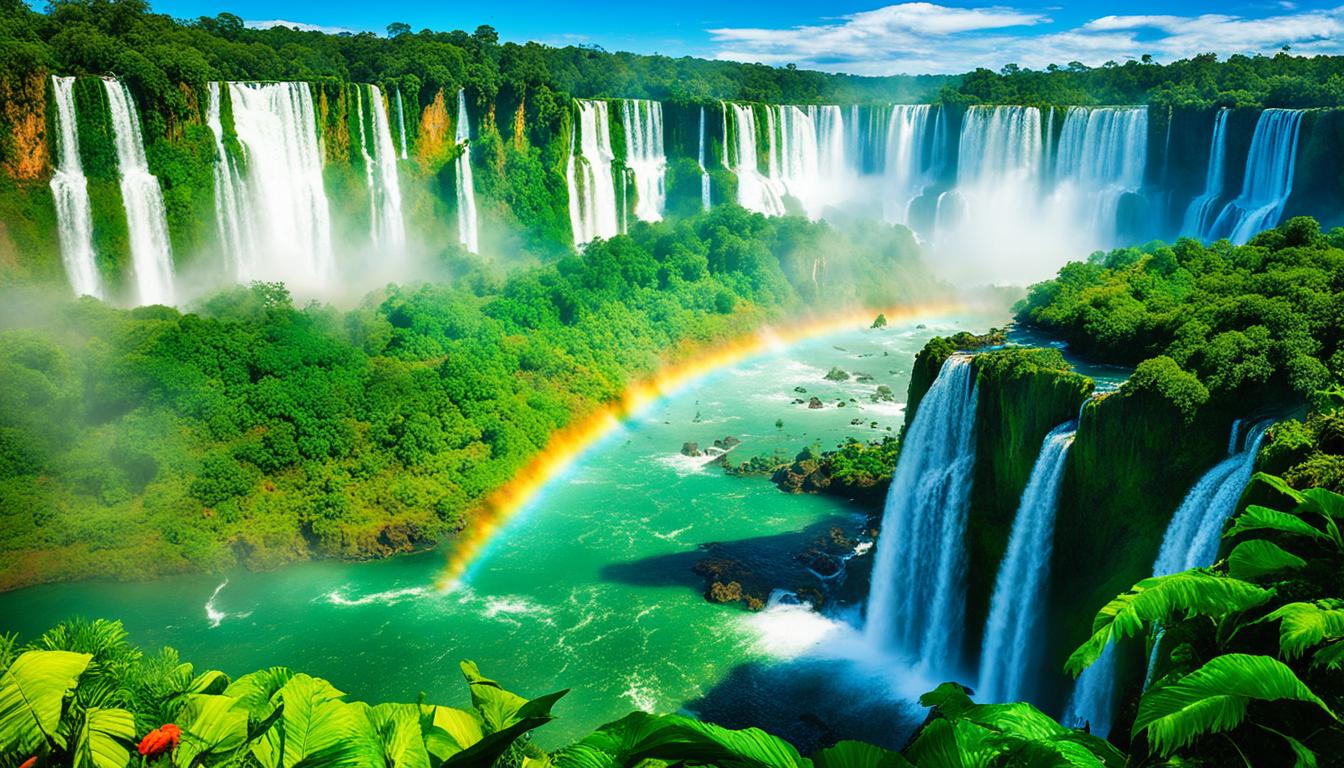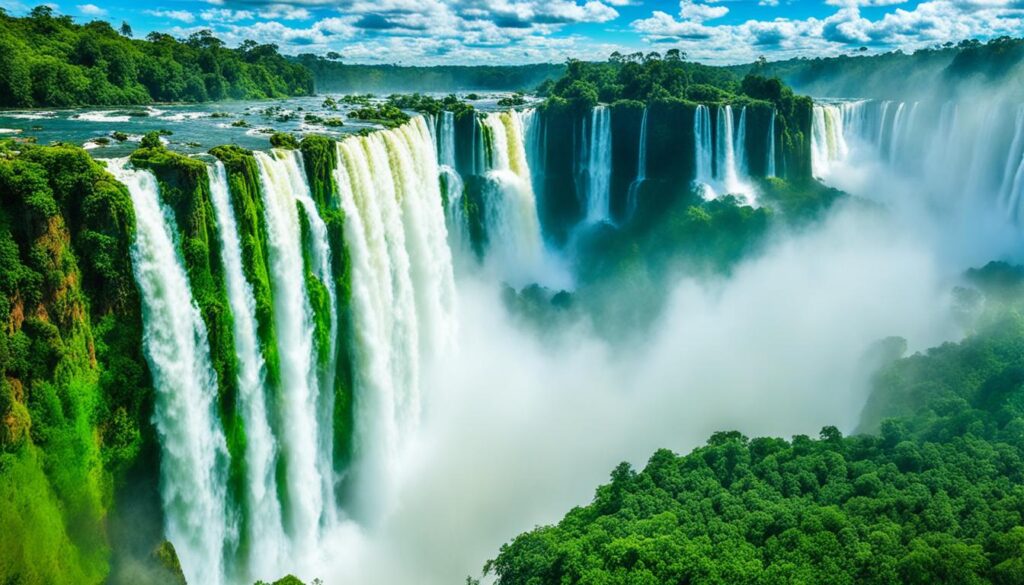
Explore Wonders at Iguazu National Park
Picture this: You’re standing on a lush green trail, surrounded by the symphony of exotic bird calls. The air is filled with a misty freshness, as if nature itself is rejuvenating your soul. And then, you catch a glimpse of it – the awe-inspiring sight that beckons adventurers from around the world. Iguazu Falls, the magnificent jewel of Iguazu National Park, rises before you, its thunderous cascades crashing into the crystal-clear waters below. In that moment, you realize that you are not just a spectator, but a part of something extraordinary.
Welcome to Iguazu National Park, a breathtaking paradise straddling the border of Argentina and Brazil. As one of the most iconic natural wonders in the world, the park is a testament to the sheer power and beauty of nature. With over 275 individual waterfalls spanning approximately 2.7 kilometers, Iguazu Falls is the largest waterfall system on the planet. Its grandeur has earned it the title of a UNESCO World Heritage Site, attracting millions of visitors each year who come to witness its majestic glory.
But Iguazu National Park is more than just a majestic waterfall – it’s an ecosystem teeming with vibrant biodiversity. Explore the park’s dense rainforests and be enchanted by the rich tapestry of wildlife that call this place home. From colorful birds soaring through the skies to elusive mammals hidden among the foliage, every step you take is an opportunity to connect with the wonders of the natural world.
Key Takeaways:
- Iguazu National Park is home to the magnificent Iguazu Falls, the largest waterfall system in the world.
- The park is a UNESCO World Heritage Site and is known for its stunning biodiversity.
- Visitors can explore hiking trails, lush rainforests, and vibrant wildlife within the park.
- Iguazu National Park is located on the border of Argentina and Brazil in South America.
- Prepare for your visit by wearing comfortable clothing, bringing sunscreen and insect repellent, and staying hydrated.
The History and Discovery of Iguazu Falls
Iguazu Falls, with its majestic beauty and thunderous power, holds a captivating history that predates European exploration. Indigenous tribes, such as the Tupi-Guaraní and Paraguas, were well aware of the falls long before Álvar Núñez Cabeza de Vaca, a Spanish explorer, arrived in 1542. Initially named “Saltos de Santa María,” Iguazu Falls earned its current name from the Tupi-Guaraní language, meaning “great water.”
The formation of Iguazu Falls can be traced back to volcanic eruptions and the movement of tectonic plates that occurred millions of years ago. This spectacular masterpiece of nature is a testament to the geology of the region and the interplay between volcanic activity and shifting continents.
“Iguazu Falls is a true wonder of nature, shaped by the forces of the Earth itself. Its history and discovery reveal a deep connection between indigenous cultures and the natural world.”
Today, Iguazu Falls stands as a renowned tourist destination, drawing visitors from around the globe who are fascinated by its historical significance and awe-inspiring beauty. It serves as a symbol of the marvels that can be found in the natural world, captivating all who witness its roaring waters and breathtaking vistas.
Iguazu National Parks: Argentina and Brazil
Iguazu National Park is a natural wonder shared by both Argentina and Brazil. This pristine paradise is divided into two sections, each offering its own unique experiences and breathtaking beauty.
The Argentine Side: Parque Nacional Iguazú
The Argentine side of Iguazu National Park, known as Parque Nacional Iguazú, covers an expansive area of 677 square kilometers. Established in 1934, it has been a protected area for decades, dedicated to preserving the region’s exceptional biodiversity and natural wonders.
In Parque Nacional Iguazú, visitors can immerse themselves in the lush greenery of the rainforest and get up close to the awe-inspiring Iguazu Falls. The park boasts an incredible variety of bird species, including toucans, parrots, and hummingbirds, making it a paradise for birdwatchers. The vibrant flora, with its colorful orchids and exotic plants, adds to the park’s vibrant ecosystem.
Exploring the Argentine side, visitors can follow well-maintained hiking trails that lead to breathtaking viewpoints, where they can witness the sheer power and beauty of the falls. The highlight is the iconic Devil’s Throat, a massive U-shaped cascade that captivates with its stunning magnitude.
The Brazilian Side: Parque Nacional do Iguaçu
On the Brazilian side of Iguazu National Park lies Parque Nacional do Iguaçu, covering an expansive area of 1,701 square kilometers. Established in 1939, this section of the park offers a different perspective and a chance to see the falls from a new angle.
Parque Nacional do Iguaçu provides visitors with panoramic views of the falls, allowing them to see the vastness and grandeur of Iguazu Falls. The park offers an array of trails and walkways that wind through the lush forest, providing unforgettable experiences and opportunities to spot unique wildlife.
One of the highlights on the Brazilian side is the Macuco Safari, an exhilarating boat tour that takes visitors close to the base of the falls, allowing them to feel the refreshing mist and witness the true power of nature.
Both the Argentine and Brazilian sides of Iguazu National Park are UNESCO World Heritage Sites, recognized for their exceptional biodiversity and conservation efforts. These parks serve as havens for a wide variety of mammals, including jaguars, capybaras, and coatis, as well as numerous plant species, showcasing the incredible richness of the region’s natural heritage.

With their captivating landscapes and abundant wildlife, Iguazu National Parks in Argentina and Brazil are destinations that offer an unparalleled connection with nature. Whether you choose to explore the Argentine side’s immersive trails or experience the Brazilian side’s panoramic views, a visit to these parks is a journey into the heart of biodiversity and a truly unforgettable experience.
Tips for Visiting Iguazu National Park
When planning a visit to Iguazu National Park, there are several tips to keep in mind. To experience the waterfalls at their fullest, it is recommended to visit during the summer months, from December to March. The park is known for its stunning beauty and can get crowded, so it’s advisable to plan your visit accordingly.
While exploring the park, make sure to stay hydrated by drinking plenty of water. With the hot and humid climate, it’s essential to take care of your well-being. Additionally, wearing comfortable clothing and sturdy hiking shoes will ensure you can comfortably navigate the park’s trails and terrain. Don’t forget to apply sunscreen and bring insect repellent to protect yourself from the sun and pesky bugs.
When it comes to accommodation, there are options available in the nearby cities of Puerto Iguazu and Foz do Iguaçu. These cities offer a range of hotels and lodges to suit different budgets and preferences. To make the most of your visit, consider booking guided tours that provide valuable insights about the park’s history, wildlife, and conservation efforts.
You can easily reach Iguazu National Park by using the available transportation options. Buses and taxis are available for convenient travel to and from the park. Additionally, within the Argentine side of the park, there is a jungle train that offers a unique and scenic way to explore its wonders. Be sure to plan your transportation ahead of time to maximize your time at the park.
While there are countless attractions in Iguazu National Park, some are absolute must-visit. The Devil’s Throat is a breathtaking highlight, with its powerful cascades and misty atmosphere. Boat tours provide a thrilling experience, taking you up close to the falls and offering a refreshing spray. Lastly, the park’s various hiking trails provide stunning views of the falls from different perspectives, allowing you to witness their grandeur up close.
Source Links
- https://www.railsouthamerica.com/blog-posts/iguazu-one-of-the-7-natural-wonders-of-the-world
- https://iguazufalls.com/national-park/
- https://explorerbysoul.com/iguazu-falls-wonders-of-nature/

Leave a Reply